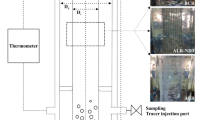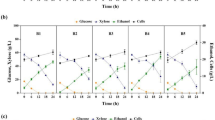Abstract
Rhizopus oryzae immobilized in calcium alginate was applied in lactic acid fermentation with unhydrolyzed raw sweet potato powders as the sole carbon source. The effects of sodium alginate concentration, calcium chloride concentration, and the immobilized bead diameter on lactic acid production were investigated. Increase in sodium alginate concentration during the gelation process would harden the immobilized capsule, which led to a decrease in lactic acid production. The increase in calcium chloride would increase the thickness of the immobilized capsule, which would increase the mass transfer resistance. Nevertheless, while the calcium chloride was lower than 15%, it would not have obvious effects on lactic acid production. A larger bead could have more space for cell growth, which led to the maximum lactic acid production observed at the 5-mm bead diameter. Moreover, results of repeated-batch operation suggested that immobilized cells could have higher stability in lactic acid production than free cells. The total cumulative lactic acid in immobilized-cell operation could increase by 55% as compared with free-cell operation after 216 h (seven repeated-batches), and no loss of amylolytic activity was observed. The results indicated that immobilized R. oryzae by Ca-alginate could be suitable for lactic acid production from unhydrolyzed raw potato powders.






Similar content being viewed by others
References
Jin, B., Huang, L. P., & Lant, P. (2003). Biotechnology Letters, 25, 1983–1987.
Bai, D. M., Li, S. Z., Liu, Z. L., & Cui, Z. F. (2008). Applied Biochemistry and Biotechnology, 144, 79–85.
Reddy, G., Altaf, M., Maveena, B. J., Venkateshwar, M., & Kumar, E. V. (2008). Biotechnology Advances, 28, 22–34.
Altaf, M., Venkateshwar, M., Srijana, M., & Reddy, G. (2007). Journal of Applied Microbiology, 103, 372–380.
Huang, L. P., Jin, B., Lant, P., & Zhou, J. (2005). Biochemical Engineering Journal, 23, 265–276.
Yu, M. C., Wang, R. C., Wang, C. Y., Duan, K. J., & Sheu, D. C. (2007). Journal of Chinese Institute Chemical Engineering, 38, 223–228.
Kosakai, Y., Park, Y. S., & Okabe, M. (1997). Biotechnology and Bioengineering, 55, 461–470.
Kourkoutas, Y., Kanellaki, M., Koutinas, A., & Tzia, C. (2005). Journal of Food Engineering, 69, 115–123.
Ganguly, R., Dwivedi, P., & Singh, R. P. (2007). Bioresource Technology, 98, 1246–1251.
Yoo, I. K., Seong, G. H., Chang, H. N., & Park, J. K. (1996). Enzyme and Microbial Technology, 19, 428–433.
Lee, S., Ebata, T., Liu, Y., & Tanaka, H. (1993). Journal of Fermentation and Bioengineering, 75, 36–42.
Xiao, Z., Storms, R., & Tsang, A. (2006). Analytical Biochemistry, 35, 146–148.
Blandino, A., Macias, M., & Canteo, D. (1999). Journal of Bioscience and Bioengineering, 88, 686–689.
Idris, A., & Suzana, W. (2006). Process Biochemistry, 41, 1117–1123.
Dong, X. Y., Bai, S., & Sun, Y. (1996). Biotechnology Letters, 18, 225–228.
Acknowledgements
The authors wish to thank the National Science Council of the R.O.C. for financial supports (NSC 97-2221-E-029-005).
Author information
Authors and Affiliations
Corresponding author
Rights and permissions
About this article
Cite this article
Yen, HW., Lee, YC. Production of Lactic Acid from Raw Sweet Potato Powders by Rhizopus Oryzae Immobilized in Sodium Alginate Capsules. Appl Biochem Biotechnol 162, 607–615 (2010). https://doi.org/10.1007/s12010-009-8884-5
Received:
Accepted:
Published:
Issue Date:
DOI: https://doi.org/10.1007/s12010-009-8884-5




